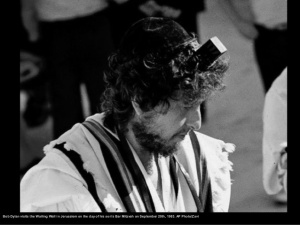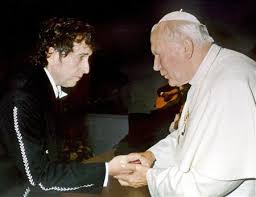https://damianbalassone.wordpress.com/2012/04/04/dylans-jokerman/
In addition to “Neighbourhood Bully” a quick run through the songs on Infidels reveal many references to Israel and/or the Hebrew Scriptures. “I and I” has references to King David, Exodus and Ecclesiastes. The outtakes from this fertile period continue the theme: “Blind Willie McTell” speaks about Jerusalem in its opening verse; “Tell Me” mentions Zion and quotes from Ecclesiastes; “Foot of Pride” has links to the Pentateuch, Psalms, Proverbs and Isaiah.(1)
All this fuelled speculation of a return to Judaism.

This brings us to “Jokerman”.
Jokerman Dance
Dylan is once again wearing his emperor of rhyme crown, employing the intricate rhyme scheme of AABCCBDD:
A Standing on the waters casting your bread
A While the eyes of the idol with the iron head
B are glowing
C Distant ships sailing into the mist
C You were born with a snake in both of your fists
B while a hurricane was blowing
D Freedom just around the corner for you
D But with the truth so far off, what good will it do?
As often is the case with Dylan, the metre is shot to pieces. On the page the lines appear overly long and even clumsy. It is the music, and, of course, Dylan’s mastery of timing and phrasing, which elevate these lyrics to poetry. His vocal is effortless. The song needs to be heard, not read, to be fully experienced.
Dylan has put together a star-studded band with the acclaimed Jamaican rhythm section of Sly Dunbar and Robbie Shakespeare providing a bouncy, light-reggae infused canvas for Dylan to paint on.

At first this refreshing musical landscape seems to compliment the ocean setting implied in the first line, but it soon becomes apparent that the lyrics are incredibly heavy and complex, in direct contrast to the light play of the music. Perhaps Dylan fully intended this strange juxtaposition of music and lyrics to perpetuate the joker theme of the song.
Each verse is concluded with a sublime change of chord that leads to a couplet i.e. the DD of the AABCCBDD rhyme scheme. In the first verse, the word “freedom” coincidences with this lovely chord change (from A to Bm) instantly reminding us why Dylan is such a great songmaker (not just a lyricist). The enunciation of the word “freedom” occurs simultaneously with the chord change, and the listener is momentarily transported (only to be told in the next line that truth is far off). The concluding couplets to each of the six verses in “Jokerman” are brilliantly executed, in much the same fashion that Byron crafted his witty couplet punchlines to his “ottava rima” stanzas in Don Juan. Dylan seems to be revealing a lot about the Jokerman in these couplets.
We find an elusive, enigmatic character being described in the first 4 verses. He is standing on the water casting bread (an image from Ecclesiastes that is linked, along with Micah 7:19, to the Jewish Tashlich ritual) while surrounded by pagan idols. He has powers – he was born with snakes in his fists (this recalls the baby Hercules who strangled two snakes who were sent to kill him by Hera, the jealous wife of Zeus, or perhaps even the divine trickster Hermes who carried a staff with two entwined snakes). Freedom is within reach, but what does it matter if truth is so far off? Is Dylan referring to a false messiah? A political entity? Himself? The final line of verse 2 implies the character is constantly engaged in an inward struggle with “the persecutor within”. Is Dylan referring to Satan? Satan in Hebrew means adversary or enemy.
The Jokerman is a man of the mountains, who walks on clouds, manipulates people and twists dreams. Thus he has powers not only to do the supernatural but to deceive. The Sodom and Gomorrah line is comical. If no-one from such a defiled place would want to marry his sister then he must be a despised man indeed.
He is a friend to both the martyr and the woman of shame. This could be either Jesus, Dylan or a political entity. Christ was merciful to many women of shame e.g. the adulterer in John 8 and the Samaritan woman at the well in John 4. He was obviously a friend to the martyr as well, as he was the one they were prepared to die for. But is Dylan implying a political entity with this line i.e. a country that has liaised with both good and bad nations for personal gain? Or some sort of charlatan?
The Jokerman looks into the fiery furnace and sees a rich man without a name. This is an allusion to Luke 16:19-31 where Christ tells the story of the rich man and the poor beggar Lazarus. They both die and the rich man goes to hell (i.e. the “fiery furnace”), while the poor man is carried by angels to heaven. Jokerman it would seem is closer to the fiery furnace than to heaven.
The next verse gives some more clues as to the Jokerman’s identity:
Well, the Book of Leviticus and DeuteronomyThe law of the jungle and the sea are your only teachers
These two books are the third and fifth books of the Pentateuch. They are concerned primarily with the Law. However the law of the jungle “kill or be killed” seems to be the opposite of such. This is deliberately confusing. The next line we have a figure riding on a milk-white steed; a figure worthy of a Michelangelo sculpture. In Revelation 19:11-13 Christ rides a white horse, although there is also a white horse mentioned in Revelation 6:2 that represents conquest. But the mention of Michelangelo changes the tone, as one of his most famous works is his statue of David – Israel’s most revered king. The next line:
Resting in the fields, far from the turbulent spaceHalf asleep near the stars with a small dog licking your face.
is harder to pinpoint, but David was on the run on a few occasions when pursued by Saul. Thus verse 4, along with the opening line in verse 1, have a very strong Jewish theme. Perhaps the Jokerman is Israel? (But why all the negative attributes then? Particularly on the same album that “Neighbourhood Bully” appears). Perhaps the Jokerman is Dylan the Jew. Confused and unsure of his powers? Returning to the faith of his youth after dabbling with Christianity? Or perhaps it is an allusion to the Fool of the Tarot card who is usually accompanied by a dog, and is utterly adrift from the ways of the world.

Verse 5 switches from the character of the Jokerman to a climate of war. Could this be the Middle East? End times? Nightsticks, cannons and Molotov cocktails are mentioned amidst riflemen, preachers and false-hearted judges. This brings us to the final verse:
It’s a shadowy world, skies are slippery greyA woman just gave birth to a prince today and dressed him in scarlet
He’ll put the priest in his pocket, put the blade to the heat
Take the motherless children off the street
And place them at the feet of a harlot
This points to Revelation 12:6 where a woman gives birth to a male-child (Christ) who we are told will rule the nations with an iron rod. However, here Dylan has the child wearing scarlet which is confusing, as this child now appears to have more in common with the scarlet beast of Revelation 17 – a beast that carries the Whore of Babylon i.e. the harlot. Is Dylan referring to this satanic creature from Revelation 17 rather than the Christ-like figure from Revelation 12? Or he is deliberately intertwining the two images to illustrate how the antichrist will deceive many? Or perhaps to illustrate his own inner-confusion?
Champions of the Reformation such as Martin Luther believed that the Whore of Babylon was the Roman Catholic Church. In this verse, Dylan refers to the priest being put in the pocket of the prince, while in “Don’t Fall Apart on Me Tonight” (the final song on Infidels) he sings “it ain’t even safe no more in the palace of the Pope.” Is Dylan aligning the Whore of Babylon and this scarlet prince with the Catholic Church? If so, it makes his performance for the Pope in 1997 even more ironic.

It has been well-documented that Dylan closely studied Hal Lindsey’s book on end times, The Late Great Planet Earth: one of the themes of the book was a link between the Roman Catholic Church and the antichrist.
But back to the song’s finale: this scarlet prince is wreaking havoc and the Jokerman is not doing anything about it – “you don’t show any response”. In fact all the while the Jokerman dances to the nightingale’s song. Traditionally a nightingale is a symbol for the poet/singer. It seems the Jokerman is more interested in the bird’s song than the havoc created by the prince. Is Dylan stating that he is merely a Jokerman who dances to the tune of the nightingale and there is nothing he can do to stop the prince? Or is the Jokerman a false Messiah who has paved the way for this scarlet prince?
dylans-ジョーカーマン
https://damianbalassone.wordpress.com/2012/04/04/dylans-jokerman/
「NeighbourhoodBully」に加えて、Infidelsの曲をざっと 見てみると、イスラエルやヘブライ語聖書への多くの言及が明らかになっています。「私と私」には、ダビデ王、出エジプト記、伝道の書への言及があります。この肥沃な時代からのアウトテイクはテーマを続けています:「ブラインドウィリーマクテル」はその冒頭の詩でエルサレムについて話します。「教えて」は、ザイオンと伝道の書からの引用に言及しています。「FootofPride」には、五書、詩篇、ことわざ、イザヤへのリンクがあります。(1)
これらすべてが、ユダヤ教への復帰についての憶測を煽った。

これが「ジョーカーマン」につながります。
ジョーカーマンダンス
ディランは再びAABCCBDDの複雑な押韻構成を採用して、彼の皇帝の押韻冠を身に着けています。
Aパンを投げる水の上に立つA
鉄の頭を持った偶像の目
が輝いている間B
霧の中を航行する遠い船
C
ハリケーンが吹いている間にB両方の拳に蛇を持って生まれた
D自由だけあなたのために角を曲がったところ
Dしかし、これまでのところ真実が遠いので、それは何をするのでしょうか?
ディランの場合によくあることですが、メーターはバラバラに撃たれます。このページでは、線が長すぎて不器用にさえ見えます。これらの歌詞を詩に昇華させるのは音楽であり、もちろん、ディランのタイミングとフレージングの習得です。彼のボーカルは楽です。歌を十分に体験するには、読むのではなく、聞く必要があります。
ディランは、スターがちりばめられたバンドを、スライダンバーとロビーシェイクスピアの絶賛されたジャマイカのリズムセクションと組み合わせて、ディランがペイントするための弾力のある、軽いレゲエが注入されたキャンバスを提供します。

最初、このさわやかな音楽の風景は、最初の行に示されている海の設定を補完しているように見えますが、音楽の軽い演奏とは正反対に、歌詞が信じられないほど重くて複雑であることがすぐに明らかになります。おそらくディランは、この曲のジョーカーのテーマを永続させるために、音楽と歌詞のこの奇妙な並置を完全に意図していました。
各詩は、連句、すなわちAABCCBDD押韻構成のDDにつながるコードの崇高な変化で終わります。最初の詩では、「自由」という言葉は、この素敵なコードの変更(AからBm)と一致し、ディランが(単なる作詞家ではなく)優れたソングメーカーである理由を即座に思い出させます。「自由」という言葉の発音は和音の変化と同時に起こり、リスナーは瞬間的に運ばれます(次の行で真実は遠く離れているとだけ言われます)。「ジョーカーマン」の6節のそれぞれの最後の連句は、バイロンがドンファンの「オッターヴァリーマ」スタンザに機知に富んだ連句パンチラインを作成したのとほぼ同じ方法で、見事に実行され ます。ディランはこれらの連句でジョーカーマンについて多くを明らかにしているようです。
最初の4節で説明されているとらえどころのない謎めいた性格を見つけます。彼は異教の偶像に囲まれている間、水を投げるパン(ミカ7:19と一緒にユダヤ人のタシュリッヒの儀式にリンクされている伝道の書からの画像)の上に立っています。彼には力があります-彼は拳にヘビを持って生まれました(これは、ゼウスの嫉妬深い妻であるヘラ、またはおそらく2人のスタッフを運んだ神のトリックスターエルメスによって彼を殺すために送られた2匹のヘビを絞め殺した赤ちゃんヘラクレスを思い出します絡み合ったヘビ)。自由は手の届くところにありますが、真実がこれほど遠くにある場合、何が問題になりますか?ディランは偽りのメシアについて言及していますか?政治的実体?彼自身?2節の最後の行は、キャラクターが「内なる迫害者」と常に内向きの闘いに従事していることを暗示しています。ディランはサタンを指していますか?ヘブライ語でサタンは敵または敵を意味します。
ジョーカーマンは山の男で、雲の上を歩き、人を操り、夢をひねります。したがって、彼は超自然的なことをするだけでなく、欺く力を持っています。ソドムとゴモラのラインはコミカルです。そのような汚された場所からの誰も彼の妹と結婚したくないなら、彼は確かに軽蔑された男でなければなりません。
彼は殉教者と恥の女の両方の友人です。これは、イエス、ディラン、または政治団体のいずれかである可能性があります。キリストは多くの恥ずべき女性、例えばヨハネ8章の姦淫者やヨハネ4章の井戸のサマリア人の女性に憐れみ深い人でした。彼は彼らが死ぬ準備ができていたので、明らかに殉教者の友人でもありました。しかし、ディランはこの線で政治的実体、すなわち個人的な利益のために善国と悪国の両方と連絡を取り合っている国を暗示しているのでしょうか?それともある種の山師?
ジョーカーマンは火の燃える炉をのぞき込み、名前のない金持ちの男を見る。これは、キリストが金持ちと貧しい物乞いのラザロの物語を語っているルカ16:19-31への言及です。彼らは両方とも死に、金持ちは地獄(すなわち「火の燃える炉」)に行き、貧しい人は天使によって天国に運ばれます。ジョーカーマンは、天国よりも火の燃える炉に近いように思われるでしょう。
次の詩は、ジョーカーマンのアイデンティティに関するいくつかの手がかりを与えます:
さて、レビ記と申命記ジャングルと海の法則はあなたの唯一の教師です
これらの2冊の本は五書の3番目と5番目の本です。彼らは主に法律に関心を持っています。しかし、「殺すか殺されるか」という弱肉強食の法則は、その逆のようです。これは意図的に混乱を招きます。次の行には、乳白色の馬に乗っている人物がいます。ミケランジェロの彫刻にふさわしい人物。黙示録19:11-13では、キリストは白い馬に乗っていますが、黙示録6:2で言及されている征服を表す白い馬もいます。しかし、彼の最も有名な作品の1つは、イスラエルで最も尊敬されている王であるダビデ像であるため、ミケランジェロについての言及は口調を変えます。次の行:
荒れ狂う空間から遠く離れた野原で休む星の近くで半分眠り、小さな犬があなたの顔をなめます。
正確に特定するのは難しいですが、デビッドはソールに追われたときに何度か逃げていました。したがって、4節は、1節の冒頭の行とともに、非常に強いユダヤ人のテーマを持っています。おそらくジョーカーマンはイスラエルですか?(しかし、なぜすべての否定的な属性がありますか?特に「NeighbourhoodBully」が登場する同じアルバムで)。おそらく、ジョーカーマンはユダヤ人のディランです。混乱して彼の力がわからない?キリスト教に手を出した後、彼の若者の信仰に戻りますか?あるいは、通常は犬を伴っており、世界のやり方から完全に漂流しているタロットカードの愚か者への言及である可能性があります。

5節はジョーカーマンの性格から戦争の風土に切り替わります。これは中東でしょうか?終了時間?警棒、大砲、火炎瓶は、ライフルマン、説教者、偽りの裁判官の間で言及されています。これは私たちを最後の詩に導きます:
それは影の世界で、空は滑りやすい灰色です女性は今日王子を出産し、緋色の服を着せました
彼は彼のポケットに司祭を入れ、刃を熱に置きます
母親のいない子供たちを通りから連れ出し
そして彼らを娼婦の足
これは、女性が男性と子供(キリスト)を産むという黙示録12:6を示しており、鉄の棒で国を支配すると言われています。しかし、ここでディランは子供が緋色を身に着けているので混乱を招きます。この子供は今や黙示録17の緋色の獣、つまり大いなるバビロンを運ぶ獣、つまり娼婦とより共通しているように見えるからです。ディランは、黙示録12のキリストのような人物ではなく、黙示録17のこの悪魔的な生き物を指していますか?それとも、反キリストがどのように多くの人を欺くかを説明するために、彼は意図的に2つの画像を絡み合わせていますか?それとも、彼自身の内面の混乱を説明するためですか?
マルティン・ルターのような改革のチャンピオンは、バビロンの娼婦がローマカトリック教会であると信じていました。この詩では、ディランは司祭が王子のポケットに入れられていることを指し、「今夜私にバラバラにならないでください」(インフィデルズの最後の歌)で彼は歌います。教皇の宮殿。」ディランはバビロンの娼婦とこの緋色の王子をカトリック教会と一致させていますか?もしそうなら、それは1997年の教皇のための彼のパフォーマンスをさらに皮肉なものにします。

ディランが終わりの時にハル・リンゼイの本、後期大惑星地球を綿密に研究したことは十分に文書化されています:本のテーマの1つはローマカトリック教会と反キリストの間のリンクでした。
しかし、曲のフィナーレに戻りましょう。この緋色の王子は大混乱を引き起こしており、ジョーカーマンはそれについて何もしていません–「あなたは何の反応も示していません」。実際、ジョーカーマンはナイチンゲールの歌に合わせて踊っています。伝統的にナイチンゲールは詩人/歌手の象徴です。ジョーカーマンは、王子が作った大混乱よりも鳥の歌に興味を持っているようです。ディランは、彼はナイチンゲールの曲に合わせて踊る単なるジョーカーマンであり、王子を止めるために彼にできることは何もないと述べていますか?それとも、ジョーカーマンはこの緋色の王子のために道を開いた偽のメシアですか?
0 件のコメント:
コメントを投稿